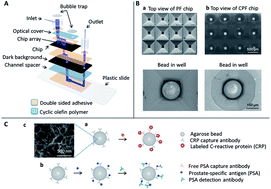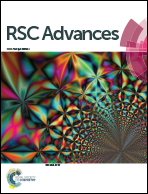Enhancement of performance in porous bead-based microchip sensors: effects of chip geometry on bio-agent capture†
Abstract
Measuring low concentrations of clinically-important biomarkers using porous bead-based lab-on-a-chip (LOC) platforms is critical for the successful implementation of point-of-care (POC) devices. One way to meet this objective is to optimize the geometry of the bead holder, referred to here as a micro-container. In this work, two geometric micro-containers were explored, the inverted pyramid frustum (PF) and the inverted clipped pyramid frustum (CPF). Finite element models of this bead array assay system were developed to optimize the micro-container and bead geometries for increased pressure, to increase analyte capture in porous bead-based fluorescence immunoassays. Custom micro-milled micro-container structures containing an inverted CPF geometry resulted in a 28% reduction in flow-through regions from traditional anisotropically-etched pyramidal geometry derived from Si-111 termination layers. This novel “reduced flow-through” design resulted in a 33% increase in analyte penetration into the bead and twofold increase in fluorescence signal intensity as demonstrated with C-reactive protein (CRP) antigen, an important biomarker of inflammation. A consequent twofold decrease in the limit of detection (LOD) and the limit of quantification (LOQ) of a proof-of-concept assay for the free isoform of prostate-specific antigen (free PSA), an important biomarker for prostate cancer detection, is also presented. Furthermore, a 53% decrease in the bead diameter is shown to result in a 160% increase in pressure and 2.5-fold increase in signal, as estimated by COMSOL models and confirmed experimentally by epi-fluorescence microscopy. Such optimizations of the bead micro-container and bead geometries have the potential to significantly reduce the LODs and reagent costs for spatially programmed bead-based assay systems of this type.


 Please wait while we load your content...
Please wait while we load your content...